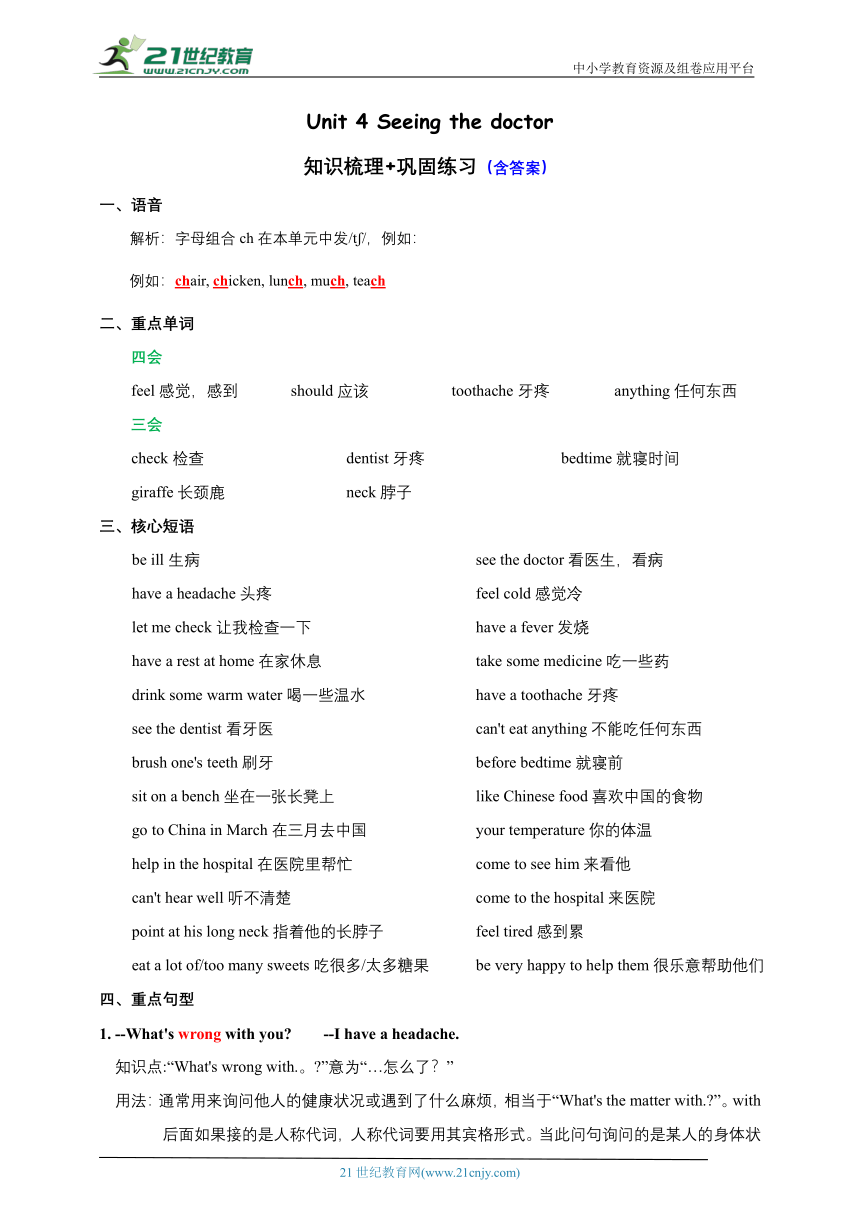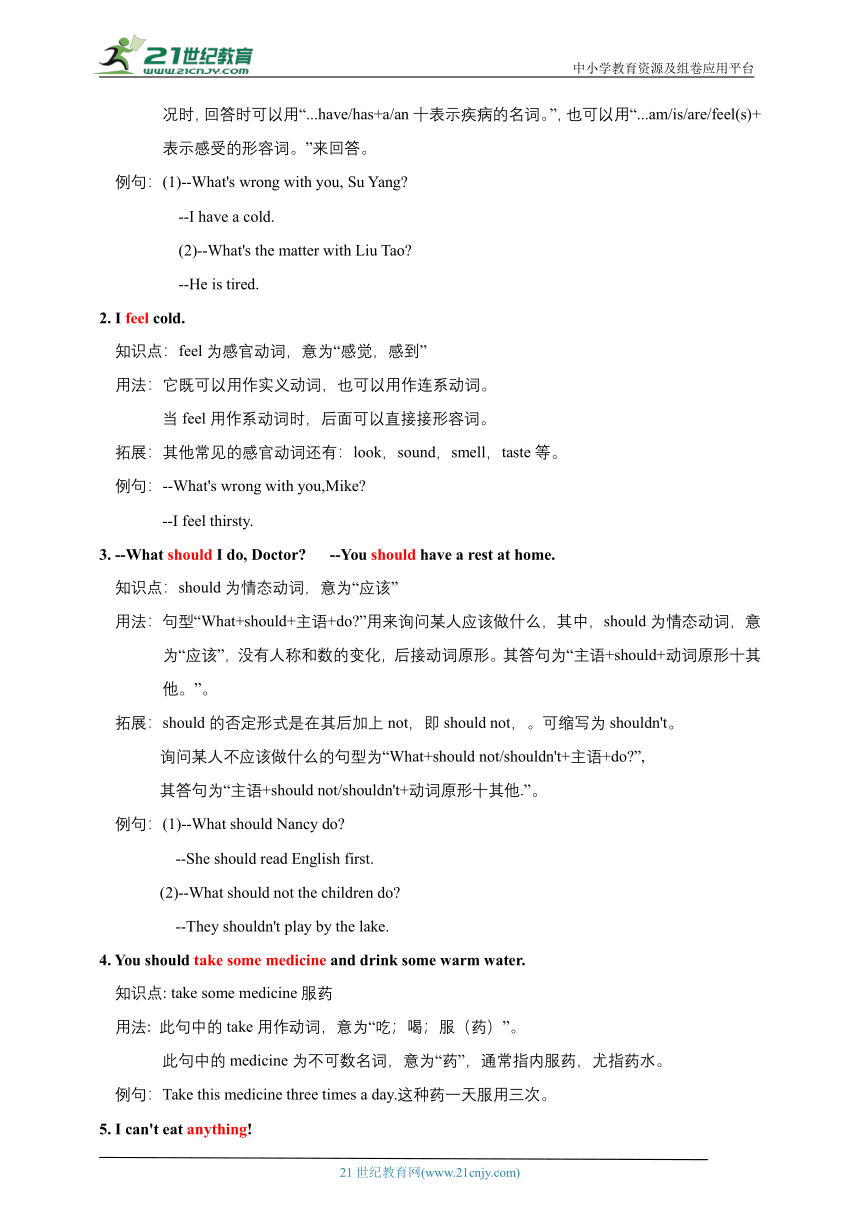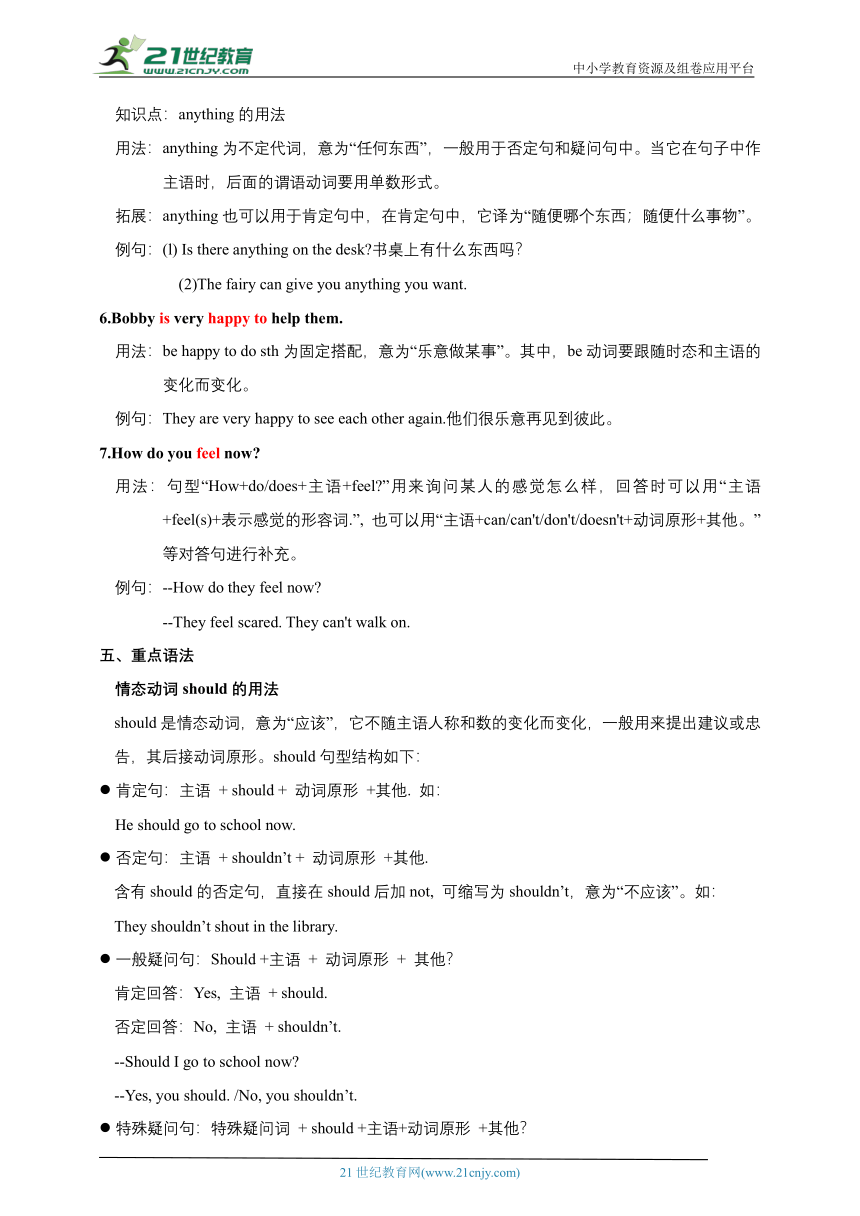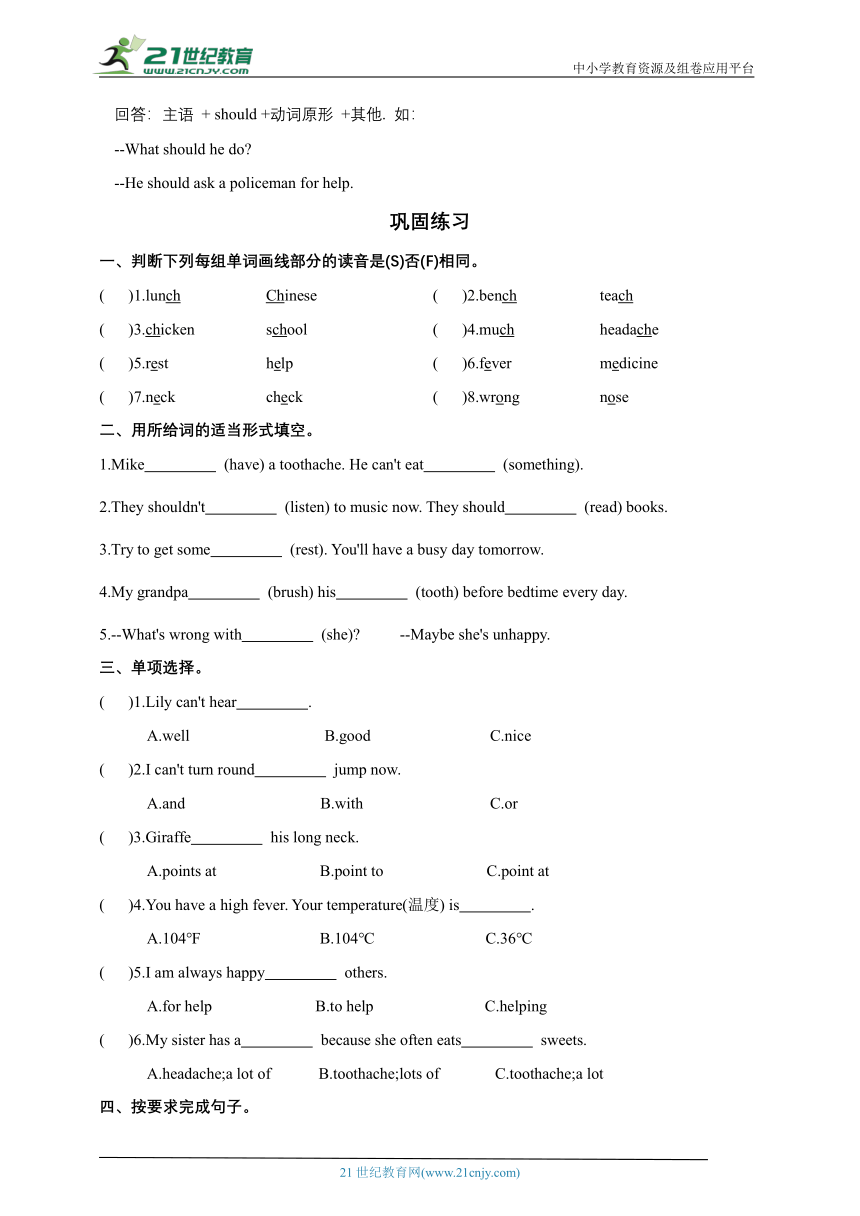【期末总复习】Unit 4 Seeing the doctor知识梳理+巩固练习(含答案)
文档属性
| 名称 | 【期末总复习】Unit 4 Seeing the doctor知识梳理+巩固练习(含答案) |  | |
| 格式 | doc | ||
| 文件大小 | 1.2MB | ||
| 资源类型 | 试卷 | ||
| 版本资源 | 牛津译林版 | ||
| 科目 | 英语 | ||
| 更新时间 | 2023-06-03 15:27:46 | ||
图片预览




文档简介
中小学教育资源及组卷应用平台
Unit 4 Seeing the doctor
知识梳理+巩固练习(含答案)
语音
解析:字母组合ch在本单元中发/t /,例如:
例如:chair, chicken, lunch, much, teach
重点单词
四会
feel感觉,感到 should应该 toothache牙疼 anything任何东西
三会
check检查 dentist牙疼 bedtime就寝时间
giraffe长颈鹿 neck脖子
核心短语
be ill生病 see the doctor看医生,看病
have a headache头疼 feel cold感觉冷
let me check让我检查一下 have a fever发烧
have a rest at home在家休息 take some medicine吃一些药
drink some warm water喝一些温水 have a toothache牙疼
see the dentist看牙医 can't eat anything不能吃任何东西
brush one's teeth刷牙 before bedtime就寝前
sit on a bench坐在一张长凳上 like Chinese food喜欢中国的食物
go to China in March在三月去中国 your temperature你的体温
help in the hospital在医院里帮忙 come to see him来看他
can't hear well听不清楚 come to the hospital来医院
point at his long neck指着他的长脖子 feel tired感到累
eat a lot of/too many sweets吃很多/太多糖果 be very happy to help them很乐意帮助他们
重点句型
1. --What's wrong with you --I have a headache.
知识点:“What's wrong with.。 ”意为“…怎么了?”
用法:通常用来询问他人的健康状况或遇到了什么麻烦,相当于“What's the matter with. ”。with后面如果接的是人称代词,人称代词要用其宾格形式。当此问句询问的是某人的身体状况时,回答时可以用“...have/has+a/an十表示疾病的名词。”,也可以用“...am/is/are/feel(s)+表示感受的形容词。”来回答。
例句:(1)--What's wrong with you, Su Yang
--I have a cold.
(2)--What's the matter with Liu Tao
--He is tired.
2. I feel cold.
知识点:feel为感官动词,意为“感觉,感到”
用法:它既可以用作实义动词,也可以用作连系动词。
当feel用作系动词时,后面可以直接接形容词。
拓展:其他常见的感官动词还有:look,sound,smell,taste等。
例句:--What's wrong with you,Mike
--I feel thirsty.
3. --What should I do, Doctor --You should have a rest at home.
知识点:should为情态动词,意为“应该”
用法:句型“What+should+主语+do ”用来询问某人应该做什么,其中,should为情态动词,意为“应该”,没有人称和数的变化,后接动词原形。其答句为“主语+should+动词原形十其他。”。
拓展:should的否定形式是在其后加上not,即should not,。可缩写为shouldn't。
询问某人不应该做什么的句型为“What+should not/shouldn't+主语+do ”,
其答句为“主语+should not/shouldn't+动词原形十其他.”。
例句:(1)--What should Nancy do
--She should read English first.
(2)--What should not the children do
--They shouldn't play by the lake.
4. You should take some medicine and drink some warm water.
知识点: take some medicine服药
用法: 此句中的take用作动词,意为“吃;喝;服(药)”。
此句中的medicine为不可数名词,意为“药”,通常指内服药,尤指药水。
例句:Take this medicine three times a day.这种药一天服用三次。
5. I can't eat anything!
知识点:anything的用法
用法:anything为不定代词,意为“任何东西”,一般用于否定句和疑问句中。当它在句子中作主语时,后面的谓语动词要用单数形式。
拓展:anything也可以用于肯定句中,在肯定句中,它译为“随便哪个东西;随便什么事物”。
例句:(l) Is there anything on the desk 书桌上有什么东西吗?
(2)The fairy can give you anything you want.
6.Bobby is very happy to help them.
用法:be happy to do sth为固定搭配,意为“乐意做某事”。其中,be动词要跟随时态和主语的变化而变化。
例句:They are very happy to see each other again.他们很乐意再见到彼此。
7.How do you feel now
用法:句型“How+do/does+主语+feel ”用来询问某人的感觉怎么样,回答时可以用“主语+feel(s)+表示感觉的形容词.”, 也可以用“主语+can/can't/don't/doesn't+动词原形+其他。”等对答句进行补充。
例句:--How do they feel now
--They feel scared. They can't walk on.
重点语法
情态动词should的用法
should是情态动词,意为“应该”,它不随主语人称和数的变化而变化,一般用来提出建议或忠告,其后接动词原形。should句型结构如下:
肯定句:主语 + should + 动词原形 +其他. 如:
He should go to school now.
否定句:主语 + shouldn’t + 动词原形 +其他.
含有should的否定句,直接在should后加not, 可缩写为shouldn’t,意为“不应该”。如:
They shouldn’t shout in the library.
一般疑问句:Should +主语 + 动词原形 + 其他?
肯定回答:Yes, 主语 + should.
否定回答:No, 主语 + shouldn’t.
--Should I go to school now
--Yes, you should. /No, you shouldn’t.
特殊疑问句:特殊疑问词 + should +主语+动词原形 +其他?
回答:主语 + should +动词原形 +其他. 如:
--What should he do
--He should ask a policeman for help.
巩固练习
判断下列每组单词画线部分的读音是(S)否(F)相同。
( )1.lunch Chinese ( )2.bench teach
( )3.chicken school ( )4.much headache
( )5.rest help ( )6.fever medicine
( )7.neck check ( )8.wrong nose
用所给词的适当形式填空。
1.Mike (have) a toothache. He can't eat (something).
2.They shouldn't (listen) to music now. They should (read) books.
3.Try to get some (rest). You'll have a busy day tomorrow.
4.My grandpa (brush) his (tooth) before bedtime every day.
5.--What's wrong with (she) --Maybe she's unhappy.
单项选择。
( )1.Lily can't hear .
A.well B.good C.nice
( )2.I can't turn round jump now.
A.and B.with C.or
( )3.Giraffe his long neck.
A.points at B.point to C.point at
( )4.You have a high fever. Your temperature(温度) is .
A.104℉ B.104℃ C.36℃
( )5.I am always happy others.
A.for help B.to help C.helping
( )6.My sister has a because she often eats sweets.
A.headache;a lot of B.toothache;lots of C.toothache;a lot
按要求完成句子。
1.May should have a rest at home. (改为否定句)
May a rest at home.
2.She has a fever. (对画线部分提问)
with
3.I brush my teeth every morning. (用John替换I改写句子)
John teeth every morning.
4.Su Hai feels cold. (对画线部分提问)
Su Hai
5.Tim, drink some cold water. (改为否定句)
Tim, cold water.
从方框中选择合适的句子完成对话。
A: You look ill. 1.
B: I have a toothache. 2.
A: Oh, I'm sorry to hear that.
B: 3.
A: I'm shopping with my friends.
B: 4.
A: They are buying some books in the bookshop.
B: OK. I have to go. 5.
根据中文提示完成句子或对话。
他感觉冷。他不应该把他的手套落在家里。
He . He his at home.
波比很乐意帮助他们。
Bobby very to .
我的左腿疼。我没法在体育课上跑步了。
My . I in the PE lesson.
--你喜欢吃什么? --中国的食物。
--What do you -- .
山姆和蒂娜来医院帮助波比。
Sam and Tina Bobby.
根据上下文及首字母提示完成短文。
“G up, Ben! It's seven thirty. It's t for kindergarten(幼儿园)!” “I f i , Dad. I can't go to kindergarten today.” “Oh, dear! I'm sorry to hear that. You s have a good r at home. Let Daddy make something fun for you." Then Ben's father r a s to Ben while swinging(摆动) the bed. “W a minute, Ben. Let me p
on my jacket. I will be back soon.” When Dad comes back, Ben is having great fun swinging the bed himself. “So you are not sick at all! Let's go to kindergarten now!”
参考答案
SSDDS DSD
1.has, anything 2.listen, read 3.rest 4.brushes, teeth, 5.her
ACAABB
1.shouldn’t have 2.What’s wrong, her 3.brushes his 4.How does, feel
5.don’t think any
DBECA
1.feels cold, shouldn’t leave, gloves
2.is, happy, help them
3.left leg hurts, can’t run
4.like eating, Chinese food
5.come to the hospital to help
Get, time, feel, ill, should, rest, reads, story, Wait, put
A.See you tomorrow.
B.I'm going to hospital.
C.Where are your friends
D.What's wrong with you
E.What are you doing here
HYPERLINK "http://21世纪教育网(www.21cnjy.com)
" 21世纪教育网(www.21cnjy.com)
Unit 4 Seeing the doctor
知识梳理+巩固练习(含答案)
语音
解析:字母组合ch在本单元中发/t /,例如:
例如:chair, chicken, lunch, much, teach
重点单词
四会
feel感觉,感到 should应该 toothache牙疼 anything任何东西
三会
check检查 dentist牙疼 bedtime就寝时间
giraffe长颈鹿 neck脖子
核心短语
be ill生病 see the doctor看医生,看病
have a headache头疼 feel cold感觉冷
let me check让我检查一下 have a fever发烧
have a rest at home在家休息 take some medicine吃一些药
drink some warm water喝一些温水 have a toothache牙疼
see the dentist看牙医 can't eat anything不能吃任何东西
brush one's teeth刷牙 before bedtime就寝前
sit on a bench坐在一张长凳上 like Chinese food喜欢中国的食物
go to China in March在三月去中国 your temperature你的体温
help in the hospital在医院里帮忙 come to see him来看他
can't hear well听不清楚 come to the hospital来医院
point at his long neck指着他的长脖子 feel tired感到累
eat a lot of/too many sweets吃很多/太多糖果 be very happy to help them很乐意帮助他们
重点句型
1. --What's wrong with you --I have a headache.
知识点:“What's wrong with.。 ”意为“…怎么了?”
用法:通常用来询问他人的健康状况或遇到了什么麻烦,相当于“What's the matter with. ”。with后面如果接的是人称代词,人称代词要用其宾格形式。当此问句询问的是某人的身体状况时,回答时可以用“...have/has+a/an十表示疾病的名词。”,也可以用“...am/is/are/feel(s)+表示感受的形容词。”来回答。
例句:(1)--What's wrong with you, Su Yang
--I have a cold.
(2)--What's the matter with Liu Tao
--He is tired.
2. I feel cold.
知识点:feel为感官动词,意为“感觉,感到”
用法:它既可以用作实义动词,也可以用作连系动词。
当feel用作系动词时,后面可以直接接形容词。
拓展:其他常见的感官动词还有:look,sound,smell,taste等。
例句:--What's wrong with you,Mike
--I feel thirsty.
3. --What should I do, Doctor --You should have a rest at home.
知识点:should为情态动词,意为“应该”
用法:句型“What+should+主语+do ”用来询问某人应该做什么,其中,should为情态动词,意为“应该”,没有人称和数的变化,后接动词原形。其答句为“主语+should+动词原形十其他。”。
拓展:should的否定形式是在其后加上not,即should not,。可缩写为shouldn't。
询问某人不应该做什么的句型为“What+should not/shouldn't+主语+do ”,
其答句为“主语+should not/shouldn't+动词原形十其他.”。
例句:(1)--What should Nancy do
--She should read English first.
(2)--What should not the children do
--They shouldn't play by the lake.
4. You should take some medicine and drink some warm water.
知识点: take some medicine服药
用法: 此句中的take用作动词,意为“吃;喝;服(药)”。
此句中的medicine为不可数名词,意为“药”,通常指内服药,尤指药水。
例句:Take this medicine three times a day.这种药一天服用三次。
5. I can't eat anything!
知识点:anything的用法
用法:anything为不定代词,意为“任何东西”,一般用于否定句和疑问句中。当它在句子中作主语时,后面的谓语动词要用单数形式。
拓展:anything也可以用于肯定句中,在肯定句中,它译为“随便哪个东西;随便什么事物”。
例句:(l) Is there anything on the desk 书桌上有什么东西吗?
(2)The fairy can give you anything you want.
6.Bobby is very happy to help them.
用法:be happy to do sth为固定搭配,意为“乐意做某事”。其中,be动词要跟随时态和主语的变化而变化。
例句:They are very happy to see each other again.他们很乐意再见到彼此。
7.How do you feel now
用法:句型“How+do/does+主语+feel ”用来询问某人的感觉怎么样,回答时可以用“主语+feel(s)+表示感觉的形容词.”, 也可以用“主语+can/can't/don't/doesn't+动词原形+其他。”等对答句进行补充。
例句:--How do they feel now
--They feel scared. They can't walk on.
重点语法
情态动词should的用法
should是情态动词,意为“应该”,它不随主语人称和数的变化而变化,一般用来提出建议或忠告,其后接动词原形。should句型结构如下:
肯定句:主语 + should + 动词原形 +其他. 如:
He should go to school now.
否定句:主语 + shouldn’t + 动词原形 +其他.
含有should的否定句,直接在should后加not, 可缩写为shouldn’t,意为“不应该”。如:
They shouldn’t shout in the library.
一般疑问句:Should +主语 + 动词原形 + 其他?
肯定回答:Yes, 主语 + should.
否定回答:No, 主语 + shouldn’t.
--Should I go to school now
--Yes, you should. /No, you shouldn’t.
特殊疑问句:特殊疑问词 + should +主语+动词原形 +其他?
回答:主语 + should +动词原形 +其他. 如:
--What should he do
--He should ask a policeman for help.
巩固练习
判断下列每组单词画线部分的读音是(S)否(F)相同。
( )1.lunch Chinese ( )2.bench teach
( )3.chicken school ( )4.much headache
( )5.rest help ( )6.fever medicine
( )7.neck check ( )8.wrong nose
用所给词的适当形式填空。
1.Mike (have) a toothache. He can't eat (something).
2.They shouldn't (listen) to music now. They should (read) books.
3.Try to get some (rest). You'll have a busy day tomorrow.
4.My grandpa (brush) his (tooth) before bedtime every day.
5.--What's wrong with (she) --Maybe she's unhappy.
单项选择。
( )1.Lily can't hear .
A.well B.good C.nice
( )2.I can't turn round jump now.
A.and B.with C.or
( )3.Giraffe his long neck.
A.points at B.point to C.point at
( )4.You have a high fever. Your temperature(温度) is .
A.104℉ B.104℃ C.36℃
( )5.I am always happy others.
A.for help B.to help C.helping
( )6.My sister has a because she often eats sweets.
A.headache;a lot of B.toothache;lots of C.toothache;a lot
按要求完成句子。
1.May should have a rest at home. (改为否定句)
May a rest at home.
2.She has a fever. (对画线部分提问)
with
3.I brush my teeth every morning. (用John替换I改写句子)
John teeth every morning.
4.Su Hai feels cold. (对画线部分提问)
Su Hai
5.Tim, drink some cold water. (改为否定句)
Tim, cold water.
从方框中选择合适的句子完成对话。
A: You look ill. 1.
B: I have a toothache. 2.
A: Oh, I'm sorry to hear that.
B: 3.
A: I'm shopping with my friends.
B: 4.
A: They are buying some books in the bookshop.
B: OK. I have to go. 5.
根据中文提示完成句子或对话。
他感觉冷。他不应该把他的手套落在家里。
He . He his at home.
波比很乐意帮助他们。
Bobby very to .
我的左腿疼。我没法在体育课上跑步了。
My . I in the PE lesson.
--你喜欢吃什么? --中国的食物。
--What do you -- .
山姆和蒂娜来医院帮助波比。
Sam and Tina Bobby.
根据上下文及首字母提示完成短文。
“G up, Ben! It's seven thirty. It's t for kindergarten(幼儿园)!” “I f i , Dad. I can't go to kindergarten today.” “Oh, dear! I'm sorry to hear that. You s have a good r at home. Let Daddy make something fun for you." Then Ben's father r a s to Ben while swinging(摆动) the bed. “W a minute, Ben. Let me p
on my jacket. I will be back soon.” When Dad comes back, Ben is having great fun swinging the bed himself. “So you are not sick at all! Let's go to kindergarten now!”
参考答案
SSDDS DSD
1.has, anything 2.listen, read 3.rest 4.brushes, teeth, 5.her
ACAABB
1.shouldn’t have 2.What’s wrong, her 3.brushes his 4.How does, feel
5.don’t think any
DBECA
1.feels cold, shouldn’t leave, gloves
2.is, happy, help them
3.left leg hurts, can’t run
4.like eating, Chinese food
5.come to the hospital to help
Get, time, feel, ill, should, rest, reads, story, Wait, put
A.See you tomorrow.
B.I'm going to hospital.
C.Where are your friends
D.What's wrong with you
E.What are you doing here
HYPERLINK "http://21世纪教育网(www.21cnjy.com)
" 21世纪教育网(www.21cnjy.com)
同课章节目录
